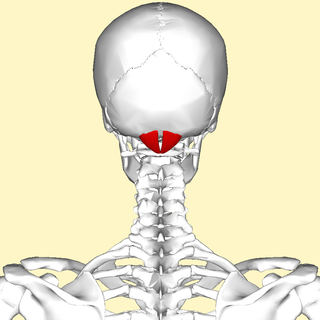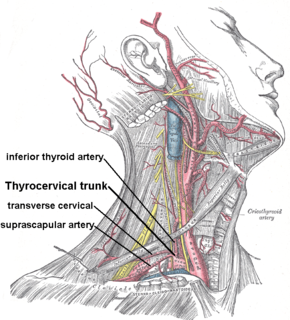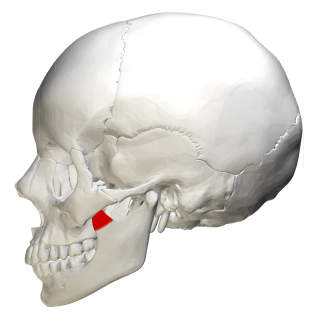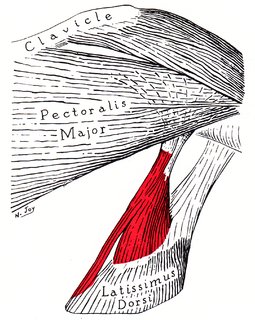
The accessory nerve is a cranial nerve that supplies the sternocleidomastoid and trapezius muscles. It is considered as the eleventh of twelve pairs of cranial nerves, or simply cranial nerve XI, as part of it was formerly believed to originate in the brain. The sternocleidomastoid muscle tilts and rotates the head, while the trapezius muscle, connecting to the scapula, acts to shrug the shoulder.

The temporal muscle, also known as the temporalis, is one of the muscles of mastication. It is a broad, fan-shaped muscle on each side of the head that fills the temporal fossa, superior to the zygomatic arch so it covers much of the temporal bone.
The MYH16 gene encodes a protein called myosin heavy chain 16, which is a muscle protein in mammals. At least in primates, it is a specialized muscle protein found only in the temporalis and masseter muscles of the jaw. Myosin heavy chain proteins are important in muscle contraction, and if they are missing, the muscles will be smaller. In non-human primates, MYH16 is functional and the animals have powerful jaw muscles. In humans, the MYH16 gene has a mutation that causes the protein not to function. Although the exact importance of this change in accounting for differences between humans and other apes is not yet clear, such a change may be related to increased brain size and finer control of the jaw, which facilitates speech. It is not clear how the MYH16 mutation relates to other changes to the jaw and skull in early human evolution.

The deltoid muscle is the muscle forming the rounded contour of the human shoulder. It is also known as the 'common shoulder muscle', particularly in other animals such as the domestic cat. Anatomically, it appears to be made up of three distinct sets of fibers though electromyography suggests that it consists of at least seven groups that can be independently coordinated by the nervous system.

Dura mater is a thick membrane made of dense irregular connective tissue that surrounds the brain and spinal cord. It is the outermost of the three layers of membrane called the meninges that protect the central nervous system. The other two meningeal layers are the arachnoid mater and the pia mater. The dura surrounds the brain and the spinal cord and is responsible for keeping in the cerebrospinal fluid. It is derived from mesoderm.

There are four classical muscles of mastication. During mastication, three muscles of mastication are responsible for adduction of the jaw, and one helps to abduct it. All four move the jaw laterally. Other muscles, usually associated with the hyoid, such as the mylohyoid muscle, are responsible for opening the jaw in addition to the lateral pterygoid.

The inguinal ligament is a band running from the pubic tubercle to the anterior superior iliac spine. It forms the base of the inguinal canal through which an indirect inguinal hernia may develop.

The brow ridge, or supraorbital ridge known as superciliary arch in medicine, refers to a bony ridge located above the eye sockets of all primates. In Homo sapiens sapiens the eyebrows are located on their lower margin.

The rectus capitis posterior minor arises by a narrow pointed tendon from the tubercle on the posterior arch of the atlas, and, widening as it ascends, is inserted into the medial part of the inferior nuchal line of the occipital bone and the surface between it and the foramen magnum, and also takes some attachment to the spinal dura mater.

The external sphincter muscle of urethra, also sphincter urethrae membranaceae, sphincter urethrae externus, surrounds the whole length of the membranous urethra, and is enclosed in the fascia of the urogenital diaphragm.
In human anatomy, the abductor pollicis longus (APL) is one of the extrinsic muscles of the hand. As the name implies, its major function is to abduct the thumb at the wrist. Its tendon forms the anterior border of the anatomical snuffbox.

In human anatomy, the adductor pollicis muscle is a muscle in the hand that functions to adduct the thumb. It has two heads: transverse and oblique.

The medial brachial cutaneous nerve is distributed to the skin on the medial brachial side of the arm.

The transverse cervical artery is an artery in the neck and a branch of the thyrocervical trunk, running at a higher level than the suprascapular artery.

The sternalismuscle is an anatomical variation that lies in front of the sternal end of the pectoralis major parallel to the margin of the sternum. The sternalis muscle may be a variation of the pectoralis major or of the rectus abdominis.

The mandible's coronoid process is a thin, triangular eminence, which is flattened from side to side and varies in shape and size.
A cadaver is a dead human body that is used by medical students, physicians and other scientists to study anatomy, identify disease sites, determine causes of death, and provide tissue to repair a defect in a living human being. Students in medical school study and dissect cadavers as a part of their education. Others who study cadavers include archaeologists and artists.

Jeffrey Todd Laitman, Ph.D. is an American anatomist and physical anthropologist whose science has combined experimental, comparative, and paleontological studies to understand the development and evolution of the human upper respiratory and vocal tract regions. He is Distinguished Professor of the Icahn School of Medicine at Mount Sinai in New York City where he holds other positions, including: Professor and Director of the Center for Anatomy and Functional Morphology, Professor of Otolaryngology and Professor of Medical Education.

The axillary arch is a variant of the latissimus dorsi muscle in humans. It is found as a slip of muscle or fascia extending between the latissimus dorsi muscle and the pectoralis major. There is considerable variation in the exact position of its origin and insertions as well as its blood and nerve supply. Its presence in different ethnic groups varies, being present in about 7% of Europeans and with higher rates in the Chinese and less common in the Turkish population. The arch may occur on one or both sides of the body.

Tensor vastus intermedius is a muscle in the anterior compartment of thigh. It lies between the vastus intermedius and the vastus lateralis. The structure has been previously reported but has not been described nor illustrated in any textbook. The term tensor vastus intermedius was given by Grob et al. in 2016.


















